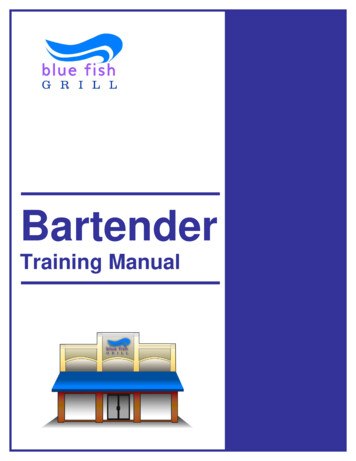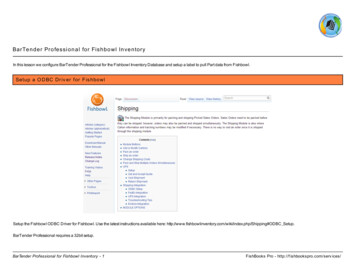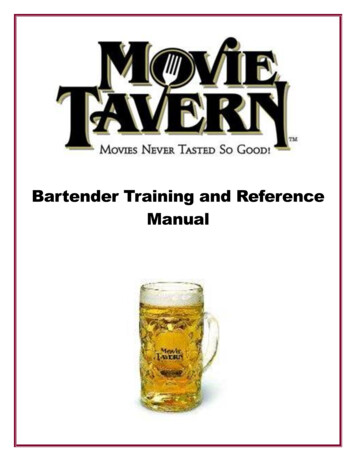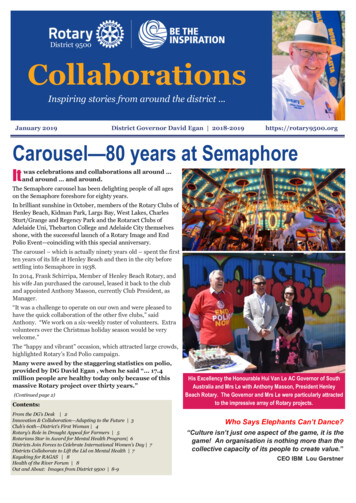
Transcription
BartenderTraining ManualTHIS TRAINING MANUAL TEMPLATESHOULD BE USED ONLY AS A GUIDE. YOUMUST REVIEW, IN DETAIL, THE VARIOUSPOLICIES, PROCEDURES AND PRACTICESAND MODIFY AS APPROPRIATE FOR YOURRESTAURANT.
Bartender Training ManualTable of ContentsINTRODUCTION .3ALCOHOL AWARENESS.4SANITATION .6SAFETY .6THE GUEST .15PERSONAL APPEARANCE .18Uniform .18SUGGESTIVE SELLING .19THE GREETING .21TAKING THE ORDER .21REGISTER OPERATIONS .23BAR STATION SETUP.24The Well.24BACK STATION SETUP .25Hot Drink Station .25ORDERING PROCEDURES.26Category .26Abbreviations .26Serving Order .26Service System .27PREPARING DRINK ORDERS .28Delivering and Serving Drinks.28SERVICE TIME .30LIQUOR LAWS .31SERVICE WELL .32Drink Basics .33STANDARDIZATION OF BEVERAGE ORDERS .35Preparing Drinks .35GLASSWARE .37ICE .39DRINK MAKING TECHNIQUES .40[Restaurant Name]18/01/2005
Bartender Training ManualGARNISHES .45CLOSING OUT A TABLE .47Presenting the Check.47The Farewell.48Methods of Payment.48OPENING, RUNNING, CLOSING DUTIES .49BAR CLEANLINESS .50END OF SHIFT RESPONSIBILITIES .51BARTENDER SECURITY RESPONSIBILITIES.53CHECK-OUT PROCEDURES .54Over Rings or Voids.54House Promo .55Manager Promo .55Employee Discount/Customer Discount .55TIP POOL .57PERFORMANCE STANDARDS .58FRONT OF THE HOUSE PROCEDURES .62CONCLUSION .63[Restaurant Name]28/01/2005
Bartender Training ManualIntroductionCongratulations on your employment as a bartender at [Restaurant Name]! We willprovide you with the training you need to be successful. As a bartender you'll be animportant part of each guest's experience in our restaurant. We take great pride in ourquality beverages and friendly, responsive service. Our high standards can only bemaintained through great people like you who share our values and desire to do the verybest job possible for our guests every day.The guidelines listed on the following pages have been established to help you in youreffort to provide these qualities to our guests. Along with the hands-on training you willreceive, this manual will provide answers to questions you may have regarding theoperating procedures for [Restaurant Name].Once again, welcome to the [Restaurant Name] Team![Restaurant Name]38/01/2005
Bartender Training ManualAlcohol AwarenessAlcohol Awareness is a growing concern within the HospitalityIndustry nationwide. By recognizing the "early" signs of intoxication,monitoring your customer's consumption, and treating them as youwould a guest in your own home; you fulfill your responsibility andprotect the guest.To serve or not to serve?By understanding and fulfilling your responsibilities.Your Role: Observe Monitor ReportAssisted by the guidance and support of management.Your Manager's Role: Confirm Confront Resolve[Restaurant Name]48/01/2005
Bartender Training ManualWith adherence to the company's policies.1. We will not knowingly admit obviously intoxicated for underagecustomers to the bar.2. We will not knowingly serve alcohol to an obviously intoxicated orunderage customer.3. We will offer alternatives to alcohol.4. We will create an atmosphere to promote responsible drinking.5. We will make a reasonable attempt to prevent obviously intoxicatedcustomers from driving. . . We can accurately and confidently answer that very importantquestion. Responsible service of alcohol requires a team effort. Know and watch for the signs of intoxication. If there is anyquestion, avoid further service and report to a manager who willmake the final decision and determine whether the guest shouldremain or leave. If you know what it takes to get someone drunk, you can prevent itby monitoring their consumption and offering alternatives. Do not allow drunks to come in, and do not allow intoxicatedguests to drive. Hospitality is our business. Beverage service is only one element. Cooperation between employees and management allows us toexercise a degree of influence on the behavior of our customersthat will result in an atmosphere of responsible drinking. This is just a portion of our company Alcohol Awareness program.A complete handbook with certification test is provided atorientation.[Restaurant Name]58/01/2005
Bartender Training ManualSanitationThe responsibility of management and staff to protect the public fromfood borne illness is fundamental. A food borne illness is simply adisease that is carried, or transmitted, to human beings by food.Throughout your training, you will receive information concerningproper temperatures of food storage and serving, as well as, cleanlinessstandards, proper use of chemical cleaning, and disinfectant products. Itis our objective to operate the restaurant at the highest level ofcleanliness and sanitation for the benefit of our customers andemployees.SafetyIn addition to a clean and sanitary environment, [Restaurant Name]provides a safe environment. One of our goals here at [RestaurantName] is to operate an accident-free restaurant. A safe restaurant takesteamwork and effort on everyone's part. Everyone who works withcleaning chemicals will receive training on the use of those products,and will be tested following the guidelines of OSHA HazardCommunication Standard, Title 29 Code of Federal regulations1910.1200.Safety meetings will also be used to review information presented fromthe initial training, and a safety representative will be selected for theEmployee Associate Board of Directors. Management's role is toprovide the daily monitoring of safe work practice developed fromthese meetings.Whenever you see a potential hazard, or something you notice asunsafe, notify a manager immediately.Here is a list of guidelines to follow for safety and sanitation:Major cause of food borne illness Food left in the danger zone of 40 to 140 for four or more hours.Keep all foods out of the danger zone of 40 to 140 .[Restaurant Name]68/01/2005
Bartender Training Manual Keep hot foods hot, and cold foods cold. Handle foods quickly during delivery, and put refrigerated andfrozen foods away as soon as possible. Sloppy personal hygiene habits will not be tolerated. Do not prepare food a day or more before serving. Do not serve food that is not completely cooked. Thaw foods in refrigerator, microwave, or under cold runningwater for not more than 2 hours, followed immediately by cooking. Avoid preparing food in advance, unless absolutely necessary. Inspect Foods thoroughly for freshness and wholesomeness uponreceipt, cooking, and serving. Only use sanitized equipment and table surfaces.Always wash your hands after you Smoke, eat, use the restroom; touch money, raw foods, or yourface, hair or skin; cough, sneeze, or blow your nose Comb your hair, handle anything dirty Before and after taking a breakDispose of waste properly Take garbage out frequently. Keep garbage areas clean and sealed. Clean and sanitize garbage cans regularly. Store soiled linen in a laundry bag or non-absorbing container.[Restaurant Name]78/01/2005
Bartender Training ManualKeep insects and animals out by Keeping doors closed. Taking garbage out frequently and keeping garbage areas clean. Report any holes where an animal can enter. Do not provide a free meal for any animals.Handle ice and tableware properly Use clean scoops or tongs to pick up ice; do not use hands or glass. Store scoops or tongs in a clean container, not in the ice. Do not store any food or beverage in the ice. Avoid touching food contact surface with dishes, utensils, etc.Avoid cross contamination from one food item to another Keep separate cutting boards for
cleaning chemicals will receive training on the use of those products, and will be tested following the guidelines of OSHA Hazard Communication Standard, Title 29 Code of Federal regulations 1910.1200. Safety meetings will also be used to review information presented from the initial training, and a safety representative will be selected for the











